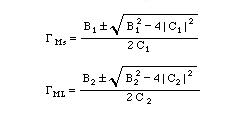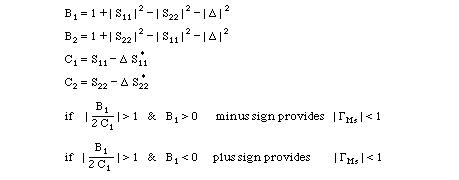
or

Simultaneous Conjugate Match (S12 not equal to 0 ).
For an unconditionally stable case, the corresponding source and load impedances (or reflection coefficients) can be calculated from

or

Solving these two equations gives the required Gs and GL. Calling these GMs and GML, we can write

where

Simultaneous conjugate match assumes that the two ports are unconditionally stable and the maximum transducer gain can be calculated. In conditionally stable cases, design procedure is best done in terms of power gain and available gain.

 Maximum transducer power gain under simultaneous conjugate match is obtained from GT by setting Gs = GMs and GL and GML.
Maximum transducer power gain under simultaneous conjugate match is obtained from GT by setting Gs = GMs and GL and GML.

Using GMs and GML and K, GT,max can be written as

Maximum stable gain is defined when K=1 which is called Maximum Stable Gain and is given by

This is also a figure of merit for the transistor.